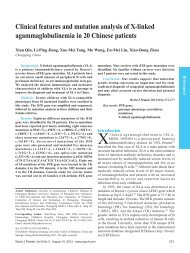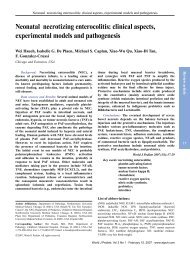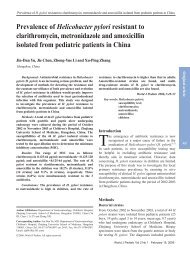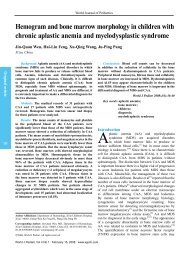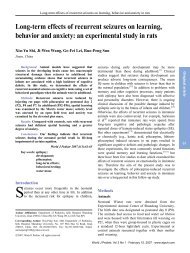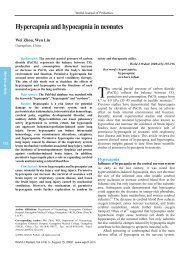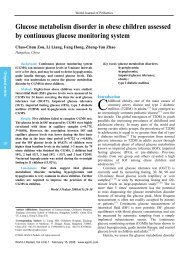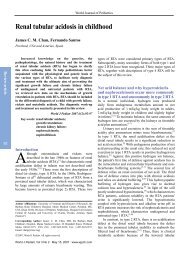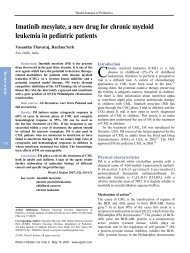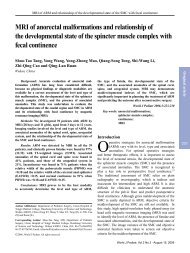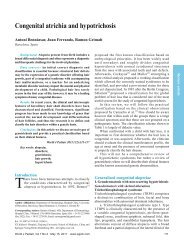Diagnosis and management of cow's milk protein ... - Wjpch.com
Diagnosis and management of cow's milk protein ... - Wjpch.com
Diagnosis and management of cow's milk protein ... - Wjpch.com
You also want an ePaper? Increase the reach of your titles
YUMPU automatically turns print PDFs into web optimized ePapers that Google loves.
Background: Cow's <strong>milk</strong> <strong>protein</strong> allergy (CMPA)<br />
is frequently suspected in infants with a variety <strong>of</strong><br />
symptoms. A thorough history <strong>and</strong> careful clinical<br />
examination are necessary to exclude other underlying<br />
diseases <strong>and</strong> to evaluate the severity <strong>of</strong> the suspected<br />
allergy. Care should be taken to diagnose CMPA<br />
adequately to avoid an unnecessary diet.<br />
Data sources: We make re<strong>com</strong>mendations based on<br />
systematic literature searches using the best-available<br />
evidence from PubMed, Cumulative Index to Nursing <strong>and</strong><br />
Allied Health Literature, <strong>and</strong> bibliographies.<br />
Results: Skin prick tests, patch tests <strong>and</strong> serum<br />
specific IgE are only indicative <strong>of</strong> CMPA. Breastfed<br />
infants have a decreased risk <strong>of</strong> developing CMPA; an<br />
elimination diet for the mother is indicated if CMPA<br />
is confirmed. If a food challenge is positive in formula<br />
fed infants, an extensively hydrolysed formula <strong>and</strong><br />
<strong>cow's</strong> <strong>milk</strong>-free diet is re<strong>com</strong>mended. If symptoms<br />
do not improve, an amino acid based formula should<br />
be considered. In severe CMPA with life-threatening<br />
symptoms, an amino-acid formula is re<strong>com</strong>mended.<br />
Conclusions: Elimination diet by a double-blind<br />
placebo controlled food challenge is the gold st<strong>and</strong>ard for<br />
diagnosis. Elimination <strong>of</strong> the <strong>of</strong>fending allergen from the<br />
infants' diet is the main treatment principle.<br />
World J Pediatr 2012;8(1):19-24<br />
Key words: amino acid formula;<br />
<strong>cow's</strong> <strong>milk</strong> <strong>protein</strong> allergy;<br />
extensive hydrolysate;<br />
partial hydrolysate;<br />
soy formula<br />
Author Affiliations: Department <strong>of</strong> Pediatrics, UZ Brussel, Brussels,<br />
Belgium (De Greef E, Hauser B, Devreker T, Veereman-Wauters G,<br />
V<strong>and</strong>enplas Y)<br />
Corresponding Author: Yvan V<strong>and</strong>enplas, MD, PhD, Department <strong>of</strong><br />
Pediatrics, UZ Brussel, Vrije Universiteit Brussel, Brussels, Belgium (Tel:<br />
02 477 57 81; Fax: 02 477 57 83; Email: yvan.v<strong>and</strong>enplas@uzbrussel.be)<br />
doi: 10.1007/s12519-012-0332-x<br />
©Children's Hospital, Zhejiang University School <strong>of</strong> Medicine, China <strong>and</strong><br />
Springer-Verlag Berlin Heidelberg 2012. All rights reserved.<br />
Cow's <strong>milk</strong> <strong>protein</strong> allergy<br />
<strong>Diagnosis</strong> <strong>and</strong> <strong>management</strong> <strong>of</strong> <strong>cow's</strong> <strong>milk</strong> <strong>protein</strong><br />
allergy in infants<br />
Elisabeth De Greef, Bruno Hauser, Thierry Devreker, Gigi Veereman-Wauters, Yvan<br />
V<strong>and</strong>enplas<br />
Brussels, Belgium<br />
Introduction<br />
Cow's <strong>milk</strong> <strong>protein</strong> allergy (CMPA) is defined<br />
as an immunological reaction to one or more<br />
<strong>milk</strong> <strong>protein</strong>s. [1] A variety <strong>of</strong> symptoms can be<br />
suggestive for CMPA. CMPA is suspected clinically<br />
in 1%-17% <strong>of</strong> infants, [2,3] while most estimates for the<br />
prevalence <strong>of</strong> CMPA vary from only 2% to 3%. [1,3]<br />
Confusion regarding CMPA prevalence is <strong>of</strong>ten due<br />
to differences in the study population <strong>and</strong> a lack <strong>of</strong><br />
defined diagnostic criteria for CMPA. The importance<br />
<strong>of</strong> defined diagnostic criteria needs to be emphasized. It<br />
precludes infants from an unnecessary diet [4] <strong>and</strong> avoids<br />
delay in diagnosis, which can lead to malnutrition. [5]<br />
The intention <strong>of</strong> this manuscript is to help<br />
pediatricians to diagnose <strong>and</strong> manage CMPA. Most <strong>of</strong><br />
the re<strong>com</strong>mendations are based on the recently published<br />
guidelines on CMPA diagnosis <strong>and</strong> <strong>management</strong>. [3,4,6-9]<br />
Manifestations<br />
CMPA may develop in breastfed <strong>and</strong> <strong>cow's</strong> <strong>milk</strong> formula<br />
fed infants <strong>and</strong> usually occurs within the first weeks after<br />
<strong>cow's</strong> <strong>milk</strong> introduction. The presentation is variable;<br />
no symptom is pathognomonic. Manifestations mainly<br />
occur at the level <strong>of</strong> the digestive tract (50%-60%), the<br />
skin (50%-60%), <strong>and</strong> the respiratory tract (20%-30%). [2]<br />
They vary from mild-moderate to severe (Table).<br />
There are two clinical types <strong>of</strong> CMPA: immediate<br />
<strong>and</strong> delayed types. The immediate type presents shortly<br />
after ingestion <strong>of</strong> <strong>cow's</strong> <strong>milk</strong> <strong>protein</strong> (CMP) (urticaria,<br />
angio-edema, vomiting or an acute flare <strong>of</strong> atopic<br />
dermatitis) <strong>and</strong> is present in slightly more than half <strong>of</strong><br />
the patients with CMPA. [10] They are more likely to<br />
have positive skin prick test (SPT) (wheel size >3 mm)<br />
or positive serum specific immunoglobulin e (IgE). [10]<br />
Another immediate reaction due to food hypersensitivity<br />
is food <strong>protein</strong> induced enterocolitis syndrome. It can<br />
be caused by <strong>cow's</strong> <strong>milk</strong> <strong>protein</strong>, but is probably cell<br />
mediated with negative specific IgE. It is recognized<br />
as a separate allergic entity early in life presenting<br />
with severe gastrointestinal symptoms <strong>and</strong> metabolic<br />
acidosis. The amount <strong>of</strong> <strong>cow's</strong> <strong>milk</strong> necessary to elicit<br />
World J Pediatr, Vol 8 No 1 . February 15, 2012 . www.wjpch.<strong>com</strong> 19<br />
Review article
Review article<br />
an immediate reaction varies from one drop to more<br />
than 150 mL, which shows that some patients tolerate<br />
a considerable amount <strong>of</strong> <strong>milk</strong> before manifestations<br />
develop. [11] Delayed reactions such as atopic dermatitis<br />
or gastrointestinal manifestations like proctocolitis or<br />
enteropathy, usually present after hours or days.<br />
Immunologically, CMPA can be IgE or non-IgE<br />
mediated. [12] IgE mediated reactions are clinically more<br />
<strong>of</strong>ten <strong>of</strong> the immediate type <strong>and</strong> can be confirmed with<br />
SPT or serum specific IgE. Non-IgE mediated reactions<br />
are due to a cellular immune response or to a mixed<br />
immune response in which IgE <strong>and</strong> immune cells play a<br />
role. This type <strong>of</strong> reaction is more difficult to be proved<br />
by specific testing.<br />
<strong>Diagnosis</strong><br />
None <strong>of</strong> the diagnostic tests available in routine clinical<br />
situations proves or excludes CMPA <strong>com</strong>pletely. [11] A<br />
thorough history, including family history <strong>of</strong> atopy,<br />
<strong>and</strong> a careful clinical examination are therefore the<br />
key elements in the diagnostic process. Clinicians<br />
may perform SPT (preferable with fresh <strong>cow's</strong> <strong>milk</strong> or<br />
Table. Clinical manifestations suggesting <strong>cow's</strong> <strong>milk</strong> <strong>protein</strong> allergy<br />
Severe manifestations<br />
Gastrointestinal tract<br />
Failure to thrive<br />
Iron deficiency anemia<br />
Enteropathy<br />
Skin<br />
Exudative/Severe atopic dermatitis<br />
Respiratory tract<br />
Larynx edema<br />
General<br />
Anaphylaxis<br />
Moderate-mild manifestations<br />
Gastrointestinal tract<br />
Regurgitations <strong>and</strong> vomiting<br />
Diarrhea<br />
Constipation<br />
Colitis<br />
Colic/Abdominal pain<br />
Skin<br />
Atopic dermatitis<br />
Angio-edema<br />
Urticaria<br />
Swollen lips<br />
Respiratory tract<br />
Rhinitis<br />
Conjunctivitis<br />
Wheezing<br />
General<br />
Irritability<br />
20<br />
World Journal <strong>of</strong> Pediatrics<br />
whole CMP extracts), determination <strong>of</strong> specific IgE,<br />
or patch tests, but they merely indicate sensitization<br />
to the substrate <strong>and</strong> are not necessarily pro<strong>of</strong> <strong>of</strong> an<br />
allergic reaction. According to a recent study, [13] the<br />
sensitivity <strong>and</strong> specificity <strong>of</strong> the SPT is 31.8 <strong>and</strong> 90.3,<br />
respectively, <strong>and</strong> 20.5% <strong>and</strong> 88.9% <strong>of</strong> specific IgE,<br />
respectively. In cases where a food challenge can not be<br />
executed, both SPT <strong>and</strong> IgE can be used. [13] The rate <strong>of</strong><br />
outgrowing CMPA varies between 30% <strong>and</strong> 79% in IgE<br />
mediated CMPA; [14] consecutive IgE measurements can<br />
be indicative in this process. [15] If serum specific IgE<br />
<strong>and</strong>/or SPT at time <strong>of</strong> diagnosis are negative, tolerance<br />
is obtained at a younger age <strong>and</strong> the risk <strong>of</strong> severe<br />
acute reaction is small. On the contrary, persistant<br />
high IgE titers increase the risk <strong>of</strong> developing other<br />
atopic conditions like asthma, rhino-conjunctivitis <strong>and</strong><br />
atopic dermatitis. Patch testing, still a topic <strong>of</strong> on-going<br />
research, can aid in the diagnosis <strong>of</strong> non-IgE mediated<br />
reactions.<br />
Diagnostic challenge procedures<br />
A double-blind placebo-controlled challenge is<br />
considered the gold st<strong>and</strong>ard in CMPA diagnosis, but<br />
in practice only an open challenge is <strong>of</strong>ten performed. [4]<br />
The patient with suspected CMPA will follow a <strong>cow's</strong><br />
<strong>milk</strong> free diet for 2-4 weeks. Formula-fed infants<br />
get an extensively hydrolyzed formula (eHF) <strong>and</strong><br />
breastfeeding mothers follow a <strong>cow's</strong> <strong>milk</strong> free diet. If<br />
CMPA is present, clinical manifestations will disappear.<br />
Cow's <strong>milk</strong> <strong>protein</strong> is reintroduced progressively<br />
thereafter <strong>and</strong> clinical symptoms are monitored. The<br />
risk <strong>of</strong> an open challenge is an overestimation <strong>of</strong><br />
the diagnosis. [16] A double-blind placebo-controlled<br />
challenge will blind the parent <strong>and</strong> the doctor as for<br />
the introduction <strong>of</strong> <strong>cow's</strong> <strong>milk</strong> <strong>protein</strong> <strong>and</strong> is the only<br />
objective measure to make the diagnosis. Unfortunately,<br />
it is expensive, requires extensive preparation, is timeconsuming,<br />
<strong>and</strong> is difficult to perform. [17]<br />
Medical supervision during a challenge is<br />
necessary because the severity <strong>of</strong> symptoms cannot<br />
be predicted. [18,19] When additional allergy testing<br />
(serum specific IgE, SPT) is negative, life-threatening<br />
manifestations are extremely rare <strong>and</strong> a non-hospital<br />
setting with medical supervision is <strong>of</strong>ten sufficient, [20]<br />
but in patients with a history <strong>of</strong> severe reactions or<br />
high IgE levels, a hospital setting with an established<br />
protocol is indicated. The challenge can be postponed<br />
in case <strong>of</strong> severe symptoms or when the patients are<br />
still recovering on an elimination diet. In case <strong>of</strong> an<br />
unequivocal history <strong>of</strong> recent anaphylactic reaction<br />
to <strong>cow's</strong> <strong>milk</strong>, a challenge is debatable. When CMPA<br />
is confirmed, the infant should be maintained on an<br />
elimination diet until the infant is between 9-12 months<br />
or at least for 6 months, whichever occurs first. A<br />
World J Pediatr, Vol 8 No 1 . February 15, 2012 . www.wjpch.<strong>com</strong>
new challenge is then performed. Children who do<br />
not develop allergy-related manifestations during the<br />
challenge <strong>and</strong> up to one week thereafter can resume<br />
their normal diet.<br />
If the patient with CMPA is on amino acid formula<br />
(AAF) because <strong>of</strong> ongoing allergic manifestations under<br />
an eHF, the debate whether to challenge with an eHF or<br />
st<strong>and</strong>ard infant formula is still ongoing. After the initial<br />
phase, allergic symptoms may not recur on an eHF<br />
challenge <strong>and</strong> the formula can be used as a less expensive<br />
<strong>and</strong> more palatable treatment. [21] Whereas in the same<br />
patient, recurrence <strong>of</strong> symptoms after a challenge with<br />
normal <strong>cow's</strong> <strong>milk</strong> formula might be more likely.<br />
Differential diagnosis<br />
The long list <strong>of</strong> potential differential diagnoses for<br />
CMPA includes repetitive viral infections <strong>and</strong> transient<br />
lactose intolerance. Concurrent conditions can also be<br />
present, for example, troublesome regurgitation occurs<br />
in 20% <strong>of</strong> all infants, with or without CMPA. On the<br />
other h<strong>and</strong>, gastroesophageal reflux has been mentioned<br />
as a possible manifestation <strong>of</strong> CMPA. [22] CMPA has also<br />
been related to infantile colic; CMPA contributes to<br />
colic in about 10% <strong>of</strong> colicky infants. [23]<br />
Although in some young infants, a correlation<br />
between atopic dermatitis <strong>and</strong> CMPA is suggested, many<br />
cases <strong>of</strong> atopic dermatitis are not related. The younger<br />
the infant <strong>and</strong>/or the more severe the atopic dermatitis,<br />
the stronger the association appears to be. [24] Reactions<br />
to other foods (especially egg <strong>and</strong> soy, wheat, fish <strong>and</strong><br />
peanut) occur frequently <strong>and</strong> <strong>of</strong>ten in <strong>com</strong>bination<br />
with CMPA. [25] Therefore, <strong>com</strong>plementary feeding <strong>and</strong>,<br />
Cow's <strong>milk</strong> <strong>protein</strong> allergy<br />
Clinical assessment suggestive for CMPA<br />
Eliminate <strong>cow's</strong> <strong>milk</strong> from the mother's diet<br />
2-4 weeks<br />
No clinical improvement<br />
Mother returns to normal diet<br />
No clinical manifestations<br />
Mother returns to normal diet<br />
preferentially, all supplementary feeding should be<br />
avoided during the diagnostic elimination diet.<br />
Management <strong>of</strong> CMPA<br />
The principles for the <strong>management</strong> <strong>of</strong> CMPA differ in<br />
breastfed <strong>and</strong> formula fed infants.<br />
Management <strong>of</strong> CMPA in exclusively breastfed<br />
infants (Fig. 1)<br />
Breastfeeding is the gold st<strong>and</strong>ard feeding in infant<br />
nutrition <strong>and</strong> is re<strong>com</strong>mended exclusively at least for<br />
the first four months <strong>of</strong> life. [26] Only about 0.5% <strong>of</strong><br />
exclusively breast-fed infants show a reproducible<br />
clinical reaction to CMP, mostly mild to moderate. [2]<br />
Life-threatening symptoms due to CMPA in breastfed<br />
infants are extremely rare, but severe cases <strong>of</strong> <strong>protein</strong><br />
losing enteropathy <strong>and</strong> atopic dermatitis have been<br />
described. [25] Any other underlying disease should be<br />
looked for in severe cases.<br />
Due to the many benefits <strong>of</strong> breastfeeding, clinicians<br />
should advise to continue, even if the infant has CMPA.<br />
A <strong>cow's</strong> <strong>milk</strong> elimination diet for the mother is then<br />
indicated. The maintenance <strong>of</strong> a strict avoidance <strong>of</strong> CMP<br />
is m<strong>and</strong>atory if supplementary feeding is being given<br />
to the infant. [24] The elimination diet for breastfeeding<br />
mother <strong>and</strong> child should be continued for a minimum<br />
<strong>of</strong> two (to four) weeks. In cases <strong>of</strong> atopic dermatitis,<br />
symptoms may not disappear after two to four weeks.<br />
Clinical experience suggests that other food <strong>protein</strong>s,<br />
such as egg, peanut, fish <strong>and</strong> wheat may well sensitise an<br />
Clinical improvement<br />
Reintroduction <strong>of</strong> <strong>cow's</strong> <strong>milk</strong> in the mother's diet<br />
Recurrence <strong>of</strong> clinical manifestations<br />
Cow's <strong>milk</strong> free diet for the breastfeeding mother,<br />
calcium supplements, extensive hydrolyzate after<br />
breastfeeding (for 6 months or until the age <strong>of</strong> 9-12<br />
months for at least 6 months)<br />
Fig. 1. Decision tree for the diagnosis <strong>and</strong> treatment <strong>of</strong> <strong>cow's</strong> <strong>milk</strong> <strong>protein</strong> allergy (CMPA) in breastfed infants with mild to moderate symptoms.<br />
World J Pediatr, Vol 8 No 1 . February 15, 2012 . www.wjpch.<strong>com</strong> 21<br />
Review article
Review article<br />
infant through his or her mother's <strong>milk</strong>. If so, elimination<br />
diet should be adopted accordingly. Advice <strong>of</strong> a dietician<br />
is <strong>of</strong>ten required in order to help the mother to keep a<br />
nutritionally balanced diet; an adequate calcium intake<br />
(1000 mg per day) needs special attention.<br />
If symptoms disappear, <strong>cow's</strong> <strong>milk</strong> should be<br />
reintroduced in the mother's diet after 2 to 4 weeks. If<br />
symptoms relapse, the <strong>milk</strong> should be eliminated from<br />
the mother's diet as long as she is breastfeeding. When<br />
the mother wants to wean, the infant should receive<br />
an eHF. When the elimination diet fails to improve the<br />
symptoms or when the patient remains asymptomatic<br />
on reintroduction <strong>of</strong> specific food <strong>protein</strong>s, the mother<br />
should resume her normal diet.<br />
Management <strong>of</strong> CMPA in formula-fed infants (Fig. 2)<br />
Mild-moderate manifestations<br />
In formula-fed infants with mild to moderate symptoms<br />
related to CMPA, a "therapeutic formula" is the first<br />
choice. According to consensus in the literature, a<br />
therapeutic formula is a formula tolerated by at least<br />
90% (with 95% confidence) <strong>of</strong> CMPA infants. [27,28]<br />
Many eHF based on whey, casein or another <strong>protein</strong><br />
source <strong>com</strong>ply to the criteria as well as amino acidbased<br />
formula (AAF). During a diagnostic elimination<br />
diet, all other food intake should be stopped to avoid<br />
misinterpretation <strong>of</strong> manifestations due to other<br />
allergens. The CMP-free diet should be maintained for<br />
22<br />
Clinical improvement<br />
Challenge procedure<br />
World Journal <strong>of</strong> Pediatrics<br />
Clinical manifestations suggesting CMPA +/positive<br />
IgE, skin prick tests, patch tests<br />
Extensively hydrolyzed<br />
formula (2-4 weeks)<br />
Recurrence <strong>of</strong> symptoms No recurrence <strong>of</strong> symptoms<br />
Extensively hydrolyzed formula<br />
for 6 months or until the age <strong>of</strong><br />
9-12 months<br />
Mild-moderate manifestations<br />
Reintroduce <strong>cow's</strong> <strong>milk</strong><br />
<strong>protein</strong><br />
No clinical improvement<br />
at least 6 months. To maintain a balanced therapeutic<br />
diet, help <strong>of</strong> a dietician is <strong>of</strong>ten needed.<br />
Because <strong>of</strong> high cross-reactivity (up to 80%) <strong>and</strong><br />
nutritional inadequacy, the use <strong>of</strong> most animal <strong>milk</strong> is<br />
precluded. [29-31] Rice based hydrolysates, available in<br />
certain countries, may <strong>of</strong>fer an alternative approach<br />
in the treatment <strong>of</strong> CMPA. [32-34] However, any <strong>protein</strong><br />
hydrolysate, independent <strong>of</strong> its origin, has a certain<br />
residual allergenicity. Residual symptoms on eHF is<br />
<strong>of</strong>ten due to a non-IgE related mechanism. [21] Failure<br />
<strong>of</strong> eHF may be up to 10% in CMPA children in tertiary<br />
care centers. [21] There are no data available from<br />
primary health care centers.<br />
Although eHF is the treatment <strong>of</strong> choice in<br />
formula-fed CMPA infants, AAF can sometimes be<br />
indicated if symptoms persist beyond 2-4 weeks on<br />
eHF. AAF has the advantage <strong>of</strong> no residual <strong>protein</strong><br />
allergenicity, since AAF is a pure chemically made<br />
formula, not derived from <strong>cow's</strong> <strong>milk</strong> (or any native<br />
<strong>protein</strong>) containing isolated amino-acids instead <strong>of</strong><br />
peptides. If symptoms persist on an AAF, the diagnosis<br />
<strong>of</strong> CMPA should be questioned.<br />
Severe manifestations<br />
Formula-fed infants with severe CMPA should be<br />
given AAF, "the most effective" elimination diet. There<br />
is no specific evidence for the use <strong>of</strong> AAF in severe<br />
Severe manifestations<br />
Amino acid based formula<br />
No clinical improvement<br />
Diagnostic workup<br />
other underlying condition<br />
Fig. 2. Decision tree for diagnosis <strong>and</strong> treatment <strong>of</strong> formula-fed infants with suspected <strong>cow's</strong> <strong>milk</strong> <strong>protein</strong> allergy (CMPA).<br />
Clinical improvement<br />
Challenge procedure in<br />
hospital setting<br />
World J Pediatr, Vol 8 No 1 . February 15, 2012 . www.wjpch.<strong>com</strong>
symptoms, but the risk to aggravate further weight<br />
loss <strong>and</strong> nutritional deficiencies is hereby minimized.<br />
Patients with life-threatening, particularly respiratory<br />
symptoms or anaphylaxis need immediate referral to<br />
the nearest emergency department.<br />
Soy formula in CMPA<br />
The discussion on the use <strong>of</strong> soy-based infant formula<br />
is difficult, since scientific societies have different<br />
re<strong>com</strong>mendations. There is a broad consensus on the<br />
following statements: the incidence <strong>of</strong> soy allergy in<br />
soy formula-fed infants is <strong>com</strong>parable to that <strong>of</strong> CMPA<br />
in <strong>cow's</strong> <strong>milk</strong> formula-fed babies. [35] Cross reactivity to<br />
soy has been reported in 17.3% <strong>of</strong> infants with CMPA,<br />
regardless whether they were positive or negative for<br />
specific IgE for CMP. [10] In particular, infants with<br />
multiple food allergies <strong>and</strong> eosinophilic enterocolitis<br />
also react to soy <strong>protein</strong>. [36] Therefore, different<br />
specialist groups have different st<strong>and</strong>points on the use <strong>of</strong><br />
soy formula for CMPA, but the formula is generally not<br />
re<strong>com</strong>mended before the age <strong>of</strong> 6 months. [27,35,37,38] Soy<br />
could be considered as an alternative, the possible cross<br />
reactivity in mind, in cultures where the hydrolyzation<br />
process with pork-derived enzymes is considered a<br />
problem <strong>and</strong> beyond the age <strong>of</strong> 6 months.<br />
Prevention<br />
Genetic predisposition, environmental factors <strong>and</strong><br />
the influence <strong>of</strong> allergen exposure early in life may<br />
play a role in the development <strong>of</strong> allergy. [39] There<br />
are no data on the development <strong>of</strong> CMPA in atopic<br />
versus non-atopic families. A <strong>com</strong>prehensive history<br />
(including family history <strong>of</strong> atopy) <strong>and</strong> careful<br />
physical examination are therefore an important part <strong>of</strong><br />
diagnosis. Irrespective <strong>of</strong> the atopic heredity, exclusive<br />
breastfeeding remains the best nutrition for all infants<br />
up to the age <strong>of</strong> 4-6 months, even as prevention <strong>of</strong><br />
CMPA. If breastfeeding is not an option, hydrolysed<br />
formulas with proven efficacy are re<strong>com</strong>mended in high<br />
risk infants [40] <strong>com</strong>bined with the avoidance <strong>of</strong> solid<br />
food <strong>and</strong> <strong>cow's</strong> <strong>milk</strong> for the same period. [26]<br />
Conclusions<br />
CMPA can present in breastfed <strong>and</strong> formula-fed infants.<br />
The manifestations are non-pathognomonic <strong>and</strong> a<br />
<strong>com</strong>prehensive history <strong>and</strong> thorough clinical examination<br />
form the basis <strong>of</strong> the diagnosis. Confirmation with SPT,<br />
serum specific IgE or patch testing, unfortunately lack<br />
specificity <strong>and</strong> a double blind placebo controlled food<br />
challenge, remains the gold st<strong>and</strong>ard.<br />
Although several groups have published<br />
Cow's <strong>milk</strong> <strong>protein</strong> allergy<br />
re<strong>com</strong>mendations, [4,7,41] the ongoing debate on CMPA<br />
<strong>management</strong> is still dependent on the primary out<strong>com</strong>e<br />
measure chosen, i.e., most efficient or cheapest solution.<br />
Breastfeeding remains the best <strong>and</strong> cheapest option to<br />
feed healthy infants, even in CMPA. When breastfeeding<br />
is not an option, eHF in CMPA is re<strong>com</strong>mended by<br />
European consensus.<br />
Funding: No funding.<br />
Ethical approval: No ethical approval necessary.<br />
Competing interest: V<strong>and</strong>enplas Y is a consultant for United<br />
Pharmaceuticals <strong>and</strong> Biocodex. None for the other authors.<br />
Contributors: All authors contributed to the review <strong>of</strong> the<br />
literatures <strong>and</strong> writing <strong>of</strong> the manuscript.<br />
References<br />
1 Hill DJ, Firer MA, Shelton MJ, Hosking CS. Manifestations <strong>of</strong><br />
<strong>milk</strong> allergy in infancy: clinical <strong>and</strong> immunologic findings. J<br />
Pediatr 1986;109:270-276.<br />
2 Host A. Frequency <strong>of</strong> <strong>cow's</strong> <strong>milk</strong> allergy in childhood. Ann<br />
Allergy Asthma Immunol 2002;89:33-37.<br />
3 Fiocchi A, Brozek J, Schunemann H, Bahna SL, von Berg<br />
A, Beyer K, et al. World Allergy Organization (WAO)<br />
<strong>Diagnosis</strong> <strong>and</strong> Rationale for Action against Cow's Milk Allergy<br />
(DRACMA) Guidelines. Pediatr Allergy Immunol 2010;21<br />
Suppl 21:1-125.<br />
4 V<strong>and</strong>enplas Y, Koletzko S, Isolauri E, Hill D, Oranje AP,<br />
Brueton M, et al. Guidelines for the diagnosis <strong>and</strong> <strong>management</strong><br />
<strong>of</strong> <strong>cow's</strong> <strong>milk</strong> <strong>protein</strong> allergy in infants. Arch Dis Child<br />
2007;92:902-908.<br />
5 Vieira MC, Morais MB, Spolidoro JV, Toporovski MS, Cardoso<br />
AL, Araujo GT, et al. A survey on clinical presentation <strong>and</strong><br />
nutritional status <strong>of</strong> infants with suspected cow' <strong>milk</strong> allergy.<br />
BMC Pediatr 2010;10:25.<br />
6 Fiocchi A, Schunemann HJ, Brozek J, Restani P, Beyer K,<br />
Troncone R, et al. <strong>Diagnosis</strong> <strong>and</strong> Rationale for Action Against<br />
Cow's Milk Allergy (DRACMA): a summary report. J Allergy<br />
Clin Immunol 2010;126:1119-1128.e1112.<br />
7 Allen KJ, Davidson GP, Day AS, Hill DJ, Kemp AS, Peake JE,<br />
et al. Management <strong>of</strong> <strong>cow's</strong> <strong>milk</strong> <strong>protein</strong> allergy in infants <strong>and</strong><br />
young children: an expert panel perspective. J Paediatr Child<br />
Health 2009;45:481-486.<br />
8 Kneepkens CM, Meijer Y. Clinical practice. <strong>Diagnosis</strong> <strong>and</strong><br />
treatment <strong>of</strong> <strong>cow's</strong> <strong>milk</strong> allergy. Eur J Pediatr 2009;168:891-<br />
896.<br />
9 Boyce JA, Assa'ad A, Burks AW, Jones SM, Sampson HA,<br />
Wood RA, et al. Guidelines for the <strong>Diagnosis</strong> <strong>and</strong> Management<br />
<strong>of</strong> Food Allergy in the United States: summary <strong>of</strong> the NIAIDsponsored<br />
expert panel report. J Am Diet Assoc;111:17-27.<br />
10 Klemola T, Vanto T, Juntunen-Backman K, Kalimo K, Korpela<br />
R, Varjonen E. Allergy to soy formula <strong>and</strong> to extensively<br />
hydrolyzed whey formula in infants with <strong>cow's</strong> <strong>milk</strong> allergy: a<br />
prospective, r<strong>and</strong>omized study with a follow-up to the age <strong>of</strong> 2<br />
years. J Pediatr 2002;140:219-224.<br />
11 Vanto T, Juntunen-Backman K, Kalimo K, Klemola T, Koivikko<br />
A, Koskinen P, et al. The patch test, skin prick test, <strong>and</strong> serum<br />
<strong>milk</strong>-specific IgE as diagnostic tools in <strong>cow's</strong> <strong>milk</strong> allergy in<br />
infants. Allergy 1999;54:837-842.<br />
12 Sicherer SH, Noone SA, Koerner CB, Christie L, Burks AW,<br />
World J Pediatr, Vol 8 No 1 . February 15, 2012 . www.wjpch.<strong>com</strong> 23<br />
Review article
Review article<br />
Sampson HA. Hypoallergenicity <strong>and</strong> efficacy <strong>of</strong> an amino acidbased<br />
formula in children with <strong>cow's</strong> <strong>milk</strong> <strong>and</strong> multiple food<br />
hypersensitivities. J Pediatr 2001;138:688-693.<br />
13 Costa AJ, Sarinho ES, Motta ME, Gomes PN, de Oliveira de<br />
Melo SM, da Silva GA. Allergy to <strong>cow's</strong> <strong>milk</strong> <strong>protein</strong>s: what<br />
contribution does hypersensitivity in skin tests have to this<br />
diagnosis? Pediatr Allergy Immunol 2011;22:e133-138.<br />
14 Wood RA. The natural history <strong>of</strong> food allergy. Pediatrics<br />
2003;111:1631-1637.<br />
15 Shek LP, Soderstrom L, Ahlstedt S, Beyer K, Sampson HA.<br />
Determination <strong>of</strong> food specific IgE levels over time can predict<br />
the development <strong>of</strong> tolerance in <strong>cow's</strong> <strong>milk</strong> <strong>and</strong> hen's egg<br />
allergy. J Allergy Clin Immunol 2004;114:387-391.<br />
16 Venter C, Pereira B, Voigt K, Grundy J, Clayton CB, Gant C,<br />
et al. Comparison <strong>of</strong> open <strong>and</strong> double-blind placebo-controlled<br />
food challenges in diagnosis <strong>of</strong> food hypersensitivity amongst<br />
children. J Hum Nutr Diet 2007;20:565-579.<br />
17 Bindslev-Jensen C, Ballmer-Weber BK, Bengtsson U, Blanco<br />
C, Ebner C, Hourihane J, et al. St<strong>and</strong>ardization <strong>of</strong> food<br />
challenges in patients with immediate reactions to foods—<br />
position paper from the European Academy <strong>of</strong> Allergology <strong>and</strong><br />
Clinical Immunology. Allergy 2004;59:690-697.<br />
18 Barbi E, Gerarduzzi T, Longo G, Ventura A. Fatal allergy as<br />
a possible consequence <strong>of</strong> long-term elimination diet. Allergy<br />
2004;59:668-669.<br />
19 Flinterman AE, Knulst AC, Meijer Y, Bruijnzeel-Koomen<br />
CA, Pasmans SG. Acute allergic reactions in children with<br />
AEDS after prolonged <strong>cow's</strong> <strong>milk</strong> elimination diets. Allergy<br />
2006;61:370-374.<br />
20 Bock SA, Sampson HA, Atkins FM, Zeiger RS, Lehrer S,<br />
Sachs M, et al. Double-blind, placebo-controlled food challenge<br />
(DBPCFC) as an <strong>of</strong>fice procedure: a manual. J Allergy Clin<br />
Immunol 1988;82:986-997.<br />
21 V<strong>and</strong>erho<strong>of</strong> JA, Murray ND, Kaufman SS, Mack DR, Antonson<br />
DL, Corkins MR, et al. Intolerance to <strong>protein</strong> hydrolysate<br />
infant formulas: an underrecognized cause <strong>of</strong> gastrointestinal<br />
symptoms in infants. J Pediatr 1997;131:741-744.<br />
22 Hill DJ, Heine RG, Cameron DJ, Catto-Smith AG, Chow CW,<br />
Francis DE, et al. Role <strong>of</strong> food <strong>protein</strong> intolerance in infants<br />
with persistent distress attributed to reflux esophagitis. J Pediatr<br />
2000;136:641-647.<br />
23 Jakobsson I, Lindberg T. Cow's <strong>milk</strong> <strong>protein</strong>s cause infantile<br />
colic in breast-fed infants: a double-blind crossover study.<br />
Pediatrics 1983;71:268-271.<br />
24 Isolauri E, Tahvanainen A, Peltola T, Arvola T. Breast-feeding<br />
<strong>of</strong> allergic infants. J Pediatr 1999;134:27-32.<br />
25 Saarinen UM, Kajosaari M. Breastfeeding as prophylaxis<br />
against atopic disease: prospective follow-up study until 17<br />
years old. Lancet 1995;346:1065-1069.<br />
26 Host A, Halken S, Muraro A, Dreborg S, Niggemann B,<br />
Aalberse R, et al. Dietary prevention <strong>of</strong> allergic diseases in<br />
infants <strong>and</strong> small children. Pediatr Allergy Immunol 2008;19:1-<br />
24<br />
World Journal <strong>of</strong> Pediatrics<br />
4.<br />
27 American Academy <strong>of</strong> Pediatrics. Committee on Nutrition.<br />
Hypoallergenic infant formulas. Pediatrics 2000;106:346-349.<br />
28 Giampietro PG, Kjellman NI, Oldaeus G, Wouters-Wesseling<br />
W, Businco L. Hypoallergenicity <strong>of</strong> an extensively hydrolyzed<br />
whey formula. Pediatr Allergy Immunol 2001;12:83-86.<br />
29 Restani P, Gaiaschi A, Plebani A, Beretta B, Cavagni G, Fiocchi<br />
A, et al. Cross-reactivity between <strong>milk</strong> <strong>protein</strong>s from different<br />
animal species. Clin Exp Allergy 1999;29:997-1004.<br />
30 Restani P, Beretta B, Fiocchi A, Ballabio C, Galli CL. Crossreactivity<br />
between mammalian <strong>protein</strong>s. Ann Allergy Asthma<br />
Immunol 2002;89:11-15.<br />
31 Spuergin P, Walter M, Schiltz E, Deichmann K, Forster J,<br />
Mueller H. Allergenicity <strong>of</strong> alpha-caseins from cow, sheep, <strong>and</strong><br />
goat. Allergy 1997;52:293-298.<br />
32 Terracciano L, Isoardi P, Arrigoni S, Zoja A, Martelli A. Use <strong>of</strong><br />
hydrolysates in the treatment <strong>of</strong> <strong>cow's</strong> <strong>milk</strong> allergy. Ann Allergy<br />
Asthma Immunol 2002;89:86-90.<br />
33 Savino F, Castagno E, Monti G, Serraino P, Peltran A, Oggero<br />
R, et al. Z-score <strong>of</strong> weight for age <strong>of</strong> infants with atopic<br />
dermatitis <strong>and</strong> <strong>cow's</strong> <strong>milk</strong> allergy fed with a rice-hydrolysate<br />
formula during the first two years <strong>of</strong> life. Acta Paediatr Suppl<br />
2005;94:115-119.<br />
34 Reche M, Pascual C, Fi<strong>and</strong>or A, Polanco I, Rivero-Urgell M,<br />
Chifre R, et al. The effect <strong>of</strong> a partially hydrolysed formula<br />
based on rice <strong>protein</strong> in the treatment <strong>of</strong> infants with <strong>cow's</strong> <strong>milk</strong><br />
<strong>protein</strong> allergy. Pediatr Allergy Immunol;21:577-585.<br />
35 ESPGHAN Committee on Nutrition, Agostoni C, Axelsson<br />
I, Goulet O, Koletzko B, Michaelsen KF, et al. Soy <strong>protein</strong><br />
infant formulae <strong>and</strong> follow-on formulae: a <strong>com</strong>mentary by the<br />
ESPGHAN Committee on Nutrition. J Pediatr Gastroenterol<br />
Nutr 2006;42:352-361.<br />
36 Nowak-Wegrzyn A, Sampson HA, Wood RA, Sicherer SH.<br />
Food <strong>protein</strong>-induced enterocolitis syndrome caused by solid<br />
food <strong>protein</strong>s. Pediatrics 2003;111:829-835.<br />
37 Bocquet A, Bresson JL, Briend A, Chouraqui JP, Darmaun<br />
D, Dupont C, et al. Infant formulas <strong>and</strong> soy <strong>protein</strong>-based<br />
formulas: current data. Arch Pediatr 2001;8:1226-1233.<br />
38 Bhatia J, Greer F. Use <strong>of</strong> soy <strong>protein</strong>-based formulas in infant<br />
feeding. Pediatrics 2008;121:1062-1068.<br />
39 Wahn U. Aspects <strong>of</strong> nutritional <strong>management</strong> <strong>of</strong> food allergy.<br />
Pediatr Allergy Immunol 2001;12 Suppl 14:75-77.<br />
40 Osborn DA, Sinn J. Formulas containing hydrolysed <strong>protein</strong> for<br />
prevention <strong>of</strong> allergy <strong>and</strong> food intolerance in infants. Cochrane<br />
Database Syst Rev 2006:CD003664.<br />
41 Kemp AS, Hill DJ, Allen KJ, Anderson K, Davidson GP, Day<br />
AS, et al. Guidelines for the use <strong>of</strong> infant formulas to treat cows<br />
<strong>milk</strong> <strong>protein</strong> allergy: an Australian consensus panel opinion.<br />
Med J Aust 2008;188:109-112.<br />
Received June 28, 2011<br />
Accepted after revision September 8, 2011<br />
World J Pediatr, Vol 8 No 1 . February 15, 2012 . www.wjpch.<strong>com</strong>



